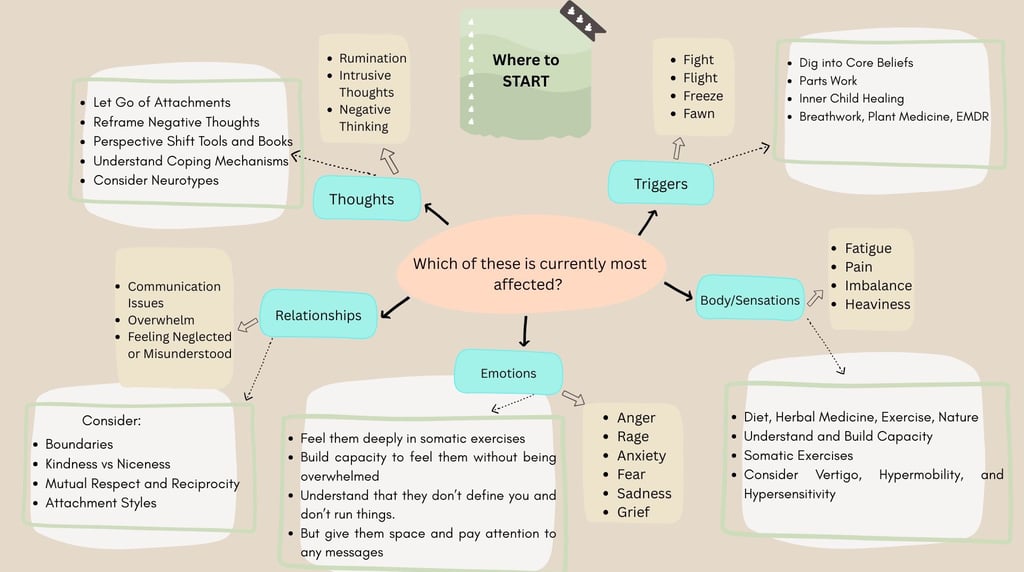From my toolkit to yours
Here is where I’ll put any free resources, tips and advice that have helped me. Everyone is different, so take what works for you and leave the rest...








How I learned to Sleep
I’ve never heard of anyone who had a harder time sleeping than me. It was like I’m an alien on the wrong planet in the wrong body and my system was simply not built for sleeping. Or at least that’s what I used to think.
I couldn’t get to sleep, I couldn’t stay asleep. I just couldn’t turn off 80% of the time. Friends and professionals gave me endless advice. I tried it all.
I didn’t start figuring out how to do it without alcohol or sleeping pills until I was well into my 30’s.
So I’m here to tell you what did finally work for me. And it wasn’t automatic. I had to slowly train my body over many years.
First, I created a sleep routine, like professionals always said to do. I made my bed a safe haven that is for night time sleeping only and not for day time hangs. I don’t always follow this, but I take steps in that direction.
I won’t go into details about my nighttime routine, as that’s something you can easily look up about how to create. Essentially, mine starts with face washing and teeth brushing, and then I move to the bed and have my comfort items and smells and sounds that I like. I found a “brown noise sound machine” on my phone that I really love.
The main thing I’m here to tell you is that I had to change my mindset about sleep. I had to stop thinking I was an alien incapable of it. I had to shift my attention to notice the times that I did sleep, and how amazing it was that the body could do that.
I had to tell myself that I was getting enough sleep and that I was okay. Even the small amount I got was keeping me alive. It was almost like lying to myself, but not quite. I just had to be very intentional with the phrasing. “If I’m tired tomorrow, it’s okay.” The number of hours of sleep I get is less important than how I respond to it in my mind. I have to be gentle, accepting, grateful. I can take the actions toward a good night's sleep as best I can and then I just have to let it go and not worry about the results.
I had to train my body that it was safe to sleep. That all was well and I was allowed to turn off. I had to be strict about phone use, and which thoughts I let my mind drift to once the bedtime routine kicked in. No more planning, no worrying, no more digging into a subject. The first half of it I could let my mind review the day, but once the lights are off I must be strict with myself; I must think about things I am not invested in.
A friend of mine says she tells herself the same boring story every single night. Something about meeting people at an airport. She describes every small uninteresting detail from the clothing being worn to the number of people in line, to the names of the airport restaurants. And it works like a charm. It gives her mind something to do and somewhere to go, without any investment in or curiosity about how things will turn out.
When I wake up in the night I also have to be quite careful about where my mind goes. Keep it soft, boring, flowing. Keep my eyes closed as much as I can, even if I have to get up. Let myself know it’s no big deal if I go back to sleep or not, what will be will be.
There’s a trick going around on social media that seems to work pretty well. With your eyes closed you look first up, then down. Then right, then left. Then you look around making a clockwork circle, then a counterclockwise one. Then repeat.
Again, this is giving you something to focus on that is gentle and flowing and not terribly interesting.
I was a nanny for a long time and this was often my trick to getting kids to sleep too. Find something the kid is mildly interested in and then do it in a very boring and gentle way.
The fact that I am staying at someone else’s house in a foreign city and that I can sleep without medication most nights is an absolute wonder. It was very hard, but not impossible, for me to imagine this scenario could come true. And incidentally, the fact that I could and did imagine it actually helped make it possible in the first place.
Activating an Abundance Mindset
When considering how to bring in more abundance in my life, I look at two things:
Where do I already have abundance?
and
Where do I have blocks keeping me from more?
There is so much abundance in this world, and we get to choose whether we focus on it or not. At this moment in time, there is an abundance of plant and animal life on this planet. There is an abundance of resources. There is an abundance of love. I meet new people pretty regularly and although they all contain both light and shadow, the majority of them are full of love in one way or another. There is an abundance of wealth on this planet. There is the possibility of more wealth and increasing wealth. Health is abundance. Think about all that your body is doing and performing to keep you sustained and thriving in so many different ways. In nature, trees grow fruit so easily, dandelions grow in the cracks of sidewalks, desert plants grow in the harshest of climates. Life is abundant.
It’s easy to start from this point of view and then look inward at where wealth and abundance and life and health flow from a more personal vantage point.
Secondly, I determine what limiting beliefs are holding me back in this area. Do I believe money is evil? Do I believe it’s not fair if I have a lot of money and others don’t? Do people that have more money make selfish decisions? Is there not enough to go around? If I give my money away will it then all just be gone? How do I feel about being thrifty or about generosity?
The more you can find these small ways that you see money as scarce or as a negative, the more you can start reframing. How can I be more open in my beliefs about abundance? How can I focus more on the positive and the free movement of resources instead of on where it’s stagnant or caused problems?
Money in and of itself isn’t an evil force. It’s just representative of exchanges that happen between people and their resources. Most of us are lucky to have as much of it as we do and often take things for granted. Realizing how wonderful running water is or how incredible it as that we have several shoe choices can really make a difference in our mindset.
What to do with Anger
When you are angry:
1) Remove yourself from the situation. If you are not able to be alone, be disciplined in not acting out of anger. Remind yourself that this is not life and death and more harm than good will come from a rage based response. You will have the opportunity to take action later.
Don’t try to be nice, just be neutral and get out of there. Less is more in this case.
2) Validate the inner voice that has something to say about why you’re angry. Write down what it believes or make voice memos. How have you been wronged? What is unfair? What needs to be done? Note when issues outside of what you’re directly angry about come in. Give it a verbal outlet (but not a physical one.)
Listen, and validate. There are important messages to be heard from anger.
However, this angry part of you is like a teenager. Although they have some great points to be made, they don’t necessarily need to be running the show. They need to be heard and loved and respected first and foremost. But then you have to let them know that you are actually in charge of what actions need to be taken, and “you” encompasses a lot more than just your rage.
3) Still, DO NOT ACT. Do not take action in anger other than listening and writing (to yourself, not to others.) Making plans to act is okay, but don’t follow through.
4) Feel it as much as you have capacity for. The best way to do this is through somatic exercises. It will be challenging because Anger is here so that you don’t have to feel what’s beneath it. So it wants to be loud and will distract you from just feeling it. It will be loudly justifying yourself and passing blame and judgment. When you notice it, that’s okay, just bring your focus back to only being with the sensations as best as you can. If any other feelings come up like sadness, let them be there and be present.
5) Form a thoughtful response to it. I do this best in writing. If during step one you wrote down how it feels and why, then now you go back to each of those statements and propose a different point of view. Come from a loving and understanding point of view. But find a compromise that gets their needs met while also being kind to your body, your spirit, and any other inner voices. This is where you will come up with a solution to the original problem.
6) Continue with your day. Move your body in healthy ways. It IS possible to hold the anger while simultaneously continuing with your life. Be careful not to take any actions based in anger still, but get the things that need to be done, done. And be proud of yourself for being able to do two things at once!
7) Once the anger has passed, take the action steps you came up with in Step 5.


